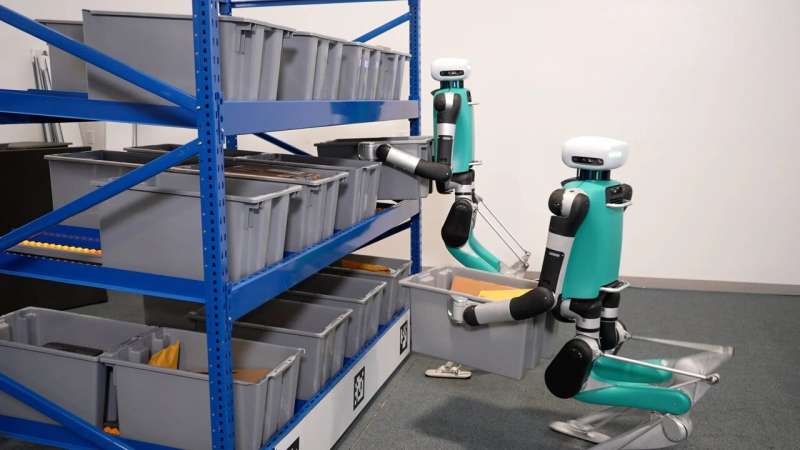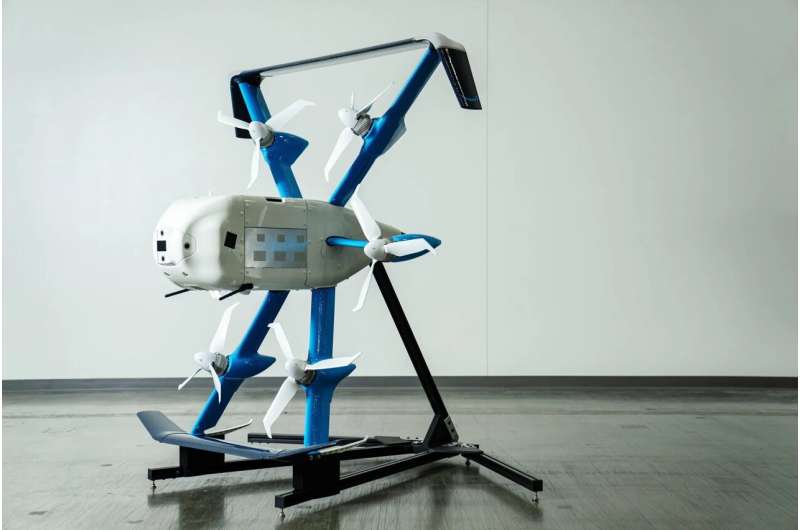This article has been reviewed according to Science X's editorial process and policies. Editors have highlighted the following attributes while ensuring the content's credibility:
fact-checked
reputable news agency
proofread
Amazon unveils new human-shaped warehouse robot, more powerful drone

Amazon employees have long worked alongside robots—but the company is now testing a very lifelike, two-legged machine to help its human co-workers with some tasks.
Amazon announced Wednesday it had begun testing a bipedal robot in its BFI1 experimental facility in Sumner, Washington. The robot is in the very early stages of development, Amazon said, so it'll be some time before it is on operational warehouse floors.
The robot, named Digit, has two arms, two legs, a blue chest and two square lights for eyes. It moves forward and backward, turns around, and bends. It can reach, grab and lift Amazon's signature yellow totes that hold items as they move through Amazon warehouses. Digit will help its human counterparts with tote recycling, Amazon said, picking up and moving empty totes once all items have been removed.
Digit's debut was one of several announcements Amazon made Wednesday at the company's Delivering the Future event, an annual roundup of updates to Amazon's transportation, delivery and fulfillment network. Amazon held the event at BFI1, one of its handful of warehouses in Sumner, where it tests new technology, equipment and work processes. The Sumner cluster of facilities includes experimental warehouses as well as operational sites.
Amazon announced it would begin delivering medications via drone in some cities and expand its drone delivery project—Prime Air—to Italy and the United Kingdom in 2024. It unveiled a new type of robotic system at work in Houston that uses robotic arms to pick totes filled with items, rather than asking employees to select an item from cubbies in yellow storage racks.
To create Digit, Amazon partnered with Agility Robotics, a technology company based in Oregon that focuses on logistics and warehouse environments.
Asked if employees would find the humanlike robot "creepy," Emily Vetterick, director of research and development for Amazon Robotics, said, "that's why we test—to get that feedback."
Worker safety
Recently, Amazon also introduced a new robotic system that would change the way the company containerized and moved items through its warehouses.
Right now, Amazon uses large yellow storage racks to move items around. The racks have cubbies for employees to either pack items into or take items out of to fulfill orders. The racks move through the warehouse using autonomous robotic drives that sit underneath the storage bins.
Its new system—dubbed Sequoia—would instead use storage racks filled with yellow or blue totes. Robotic arms would grab totes from racks and deposit them at employees' workstations, rather than having humans grab items directly from storage cubbies.
The new system, Amazon said, will improve worker safety by delivering items within employees' "power zones"—the area between mid-thigh and mid-chest. Working in the "power zone" reduces how often workers have to reach above their heads or squat to reach items.
The current yellow storage racks can require workers to climb a step ladder with two or three shelves to reach the top rung, or bend down to about 8 inches above the ground to reach the lowest shelf.
"Amazon Robotics has really pioneered the idea of goods to people," Rain Wang, a senior technical product manager at Amazon Robotics, said on a tour of Amazon's BFI1 warehouse featuring the new system. "With Sequoia, we're able to make a functional improvement to employee safety."
Sequoia would not replace all of the storage racks, Wang said. Only some Amazon sites would qualify for the new robotic system, and it's not yet clear which those will be.
The company has been under fire for years over the injury rates at its warehouses, particularly for musculoskeletal injuries, a type of injury caused by repetitive motions like reaching, squatting, pushing and pulling. In one inspection of Amazon's warehouse in DuPont, Washington, an ergonomist with the state's Department of Labor and Industries found nearly a third of Amazon workers who developed musculoskeletal disorders were off the job for at least 100 days, according to data from 2006 to 2018.
Federal workplace regulators from the Occupational Safety and Health Administration cited seven Amazon warehouses this year for unsafe working conditions, and have 20 open investigations into other facilities. Washington's department issued five citations to four warehouses for similar reasons. In Spokane, the most recent warehouse L&I cited, regulators found employees filed more than 400 workers' compensation claims for work-related musculoskeletal disorders in the three years since the facility opened.
In Washington, Amazon and L&I are weeks into a months-long trial to determine if the company put workers at risk and should be compelled to make changes to those warehouses.
Amazon has appealed the citations and says its investment in technology and training have made its warehouses safer. On Wednesday, Amazon said automation and robotics have made an impact on worker safety, citing company data from 2022 that showed recordable incident rates were 15% lower at Amazon Robotics sites than non-robotic sites.

The company says it has 750,000 robots in its network of warehouses.
Scott Dresser, the vice president of Amazon Robotics, said in an interview Wednesday the new robotics systems are not a response to heightened regulatory pressure.
"This is stuff we've been working on for way beyond some of the scrutiny we've seen recently," Dresser said. Worker safety is "just philosophically something that we think about when developing robotics."
Sequoia—with its redesigned employee workstations focused on the "power zone"—is operating at Amazon's warehouse in Houston to help with the holiday season, Wang said. Digit—which would help ease the highly repetitive motion of switching out a tote after it has been empty—is still in testing in Sumner.
More deliveries by air
Amazon also announced it will expand its drone delivery project to customers in Italy, the United Kingdom and a third, undisclosed U.S. location in late 2024.
Amazon launched Prime Air, its drone delivery system, in June 2022 in order to offer customers a fast alternative to driving to the store for some specific items, like batteries or cold medicine. Right now, drones are making deliveries to Prime customers in two locations: College Station, Texas, and Lockeford, California.
David Carbon, vice president of Prime Air, said Wednesday that Amazon would add three new locations by the end of next year. The new U.S. location would be revealed "in the coming months," Carbon said.
Starting in mid-2024, Amazon also plans to integrate its drone delivery project with some of its same-day-delivery facilities in the U.S. where Amazon stores popular items to deliver the day customers buy them. Amazon announced earlier this year it plans to double the number of same-day-delivery facilities in the U.S. in the "coming years," part of its push to create a regionalized delivery network that stores items close to customers and speeds up delivery times.
Next year, some same-day-delivery facilities will drop-off items by drone in the same way they'd make a delivery in a van, Amazon announced Wednesday.
"Same day and Prime Air just make sense," Carbon said.
Meanwhile, Amazon has also rolled out drone delivery for some medications from Amazon Pharmacy to eligible customers in College Station, Texas, the company announced Wednesday.
"Amazon will be taking prescription medication delivery quite literally to new heights," John Love, vice president of Amazon Pharmacy, said. The deliveries should take less than 60 minutes, and Amazon hopes to "expand to additional cities," Love added.
Prime Air is also testing a new way to make deliveries to apartment buildings, Carbon said, looking for a solution for customers who don't have a yard where the drone can safely drop an item. The company has been testing shared drop-off locations for residents in apartments in College Station.
Since its launch, Prime Air's drones have suffered a few crashes and the project has faced criticism over safety concerns. Cheddi Skeete, a former program manager, sued Amazon in January over accusations that the drone program was unsafe and claims that he was fired for raising concerns.
On Wednesday, Carbon emphasized that Amazon's Prime Air would be developed and held to the same safety standards used by commercial aerospace manufacturers in Europe and the United States. Amazon's safety claims will be assessed by "aerospace regulators all over the world," Carbon said, "and proven to be correct."
Once Prime Air rolls out drones in the new locations, it will also deploy an updated model of the machine, Jason Patrao, director of engineering for Prime Air, said in an interview.
The new model, the MK30, will be 40% quieter than past iterations, will be able to operate in a larger range of temperatures as well as in light rain, and can deliver to smaller areas. It will have a 15-mile range, roughly double what the drones can do today.
Customers will also no longer have to put out a marker to tell the drone where to make the drop, Patrao said. Instead, the customer can select a location on a map on their phone. The whole fleet of drones will switch to the MK30.
2023 The Seattle Times. Distributed by Tribune Content Agency, LLC.



















